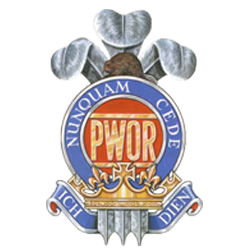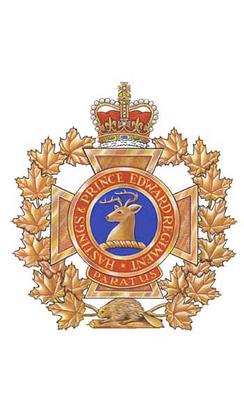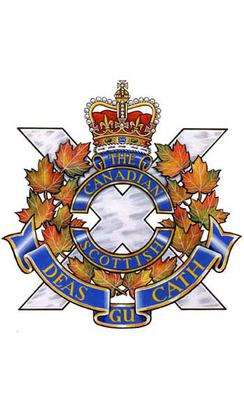Related Research Articles

The Canadian Grenadier Guards (CGG) is a reserve infantry regiment in the 34 Canadian Brigade Group, 2nd Canadian Division, of the Canadian Army. The regiment is the oldest and second-most-senior infantry regiment in the Primary Reserve of the Canadian Army. Located in Montreal, its main role is the provision of combat-ready light infantry troops in support of Canadian regular infantry. It is a Household Foot Guard regiment and also provides soldiers for public ceremonial duties, performing similar ceremonial duties as the Guards regiments of the British Army. This primarily entails mounting the guard at Government House, the King's and Governor General's residence, and performing the "Changing the Guard" ceremony on Parliament Hill in Ottawa, a task it shares with Canada's senior Household Foot Guard regiment, the Governor General's Foot Guards of Ottawa. The Canadian Grenadier Guards is an allied regiment to the British Grenadier Guards.
The Canadian Expeditionary Force (CEF) was the expeditionary field force of Canada during the First World War. It was formed following Britain’s declaration of war on the German Empire on 15 August 1914, with an initial strength of one infantry division. The division subsequently fought at Ypres on the Western Front, with a newly raised second division reinforcing the committed units to form the Canadian Corps. The CEF and corps was eventually expanded to four infantry divisions, which were all committed to the fighting in France and Belgium along the Western Front. A fifth division was partially raised in 1917, but was broken up in 1918 and used as reinforcements following heavy casualties.

The Royal Hamilton Light Infantry (Wentworth Regiment) (RHLI) is a Primary Reserve infantry regiment of the Canadian Army, based at John Weir Foote VC Armoury in Hamilton, Ontario. The RHLI is part of 31 Canadian Brigade Group, which is part of 4th Canadian Division.

The Princess of Wales' Own Regiment (PWOR) is a Primary Reserve infantry regiment of the Canadian Army.

The Hastings and Prince Edward Regiment is a Primary Reserve infantry regiment of the Canadian Army. The regiment is part of 33 Canadian Brigade Group, one of four brigade groups of 4th Canadian Division. The regimental headquarters and one company are at 187 Pinnacle Street in Belleville and on Willmott Street in Cobourg, with another rifle company in Peterborough. The Peterborough Armoury houses what was traditionally B Company or Moro Company. Moro Company also serves as the headquarters for the regiment’s Assault Pioneer Platoon. Normally, the regiment deploys as a composite, Ortona Company, while the headquarters and administration form Somme Company.

The Royal Winnipeg Rifles are a Primary Reserve one-battalion infantry regiment of the Canadian Army. Nicknamed the "Little Black Devils", they are based at Minto Armoury in Winnipeg, Manitoba. The Royal Winnipeg Rifles are part of 3rd Canadian Division's 38 Canadian Brigade Group.

The Algonquin Regiment (Northern Pioneers) is a primary reserve infantry regiment of the Canadian Army comprising two companies. A Company is located in North Bay, Ontario, and B Company is located in Timmins, Ontario. The regiment falls under the command of the 4th Canadian Division's 33 Canadian Brigade Group.

The Canadian Scottish Regiment (Princess Mary's) is a Primary Reserve infantry regiment of the Canadian Army based on Vancouver Island in British Columbia.

The 178th (Canadien-Français) Battalion, CEF was a unit in the Canadian Expeditionary Force during the First World War.
The 120th Battalion, CEF was a unit in the Canadian Expeditionary Force during the First World War. Based in Hamilton, Ontario, the unit began recruiting in late 1915 in that city and parts of Wentworth County. After sailing to England in August 1916, the battalion was absorbed into the 2nd Reserve Battalion, CEF on January 20, 1917. The 120th Battalion, CEF had one Officer Commanding: Lieut-Col. George Douglas Fearman.

The 137th Battalion, CEF, was a unit in the Canadian Expeditionary Force during the First World War. Based in Calgary, Alberta, the unit began recruiting in late 1915 in that city. After sailing to England in August 1916, the battalion was absorbed into the 21st Reserve Battalion on January 10, 1917.

The 144th Battalion, CEF was a unit in the Canadian Expeditionary Force during the First World War. Based in Winnipeg, Manitoba, the unit began recruiting in late 1915 in that city. After sailing to England in September 1916, the battalion was absorbed into the 18th Reserve Battalion on January 12, 1917. The 144th Battalion, CEF had one Officer Commanding: Lieut-Col. A. W. Morley.

The 146th Battalion, CEF was a unit in the Canadian Expeditionary Force during the First World War.

The 148th Battalion, CEF was a unit in the Canadian Expeditionary Force during the First World War. Based in Montreal, Quebec, the unit began recruiting in late 1915 in that city and the surrounding district. After sailing to England in September 1916, the battalion was absorbed into the 20th Reserve Battalion on January 8, 1917. The 148th Battalion, CEF had two Officers Commanding: Lieut-Col. A. A. Magee, and Major Alfred Soden English who had served with the 14th Battalion (RMR) in France in 1915.
The 161st (Huron) Battalion, CEF was a unit in the Canadian Expeditionary Force during the First World War. Based in London, Ontario, the unit began recruiting in late 1915 in Huron County. After sailing to England in November 1916, the battalion was absorbed into the 4th Reserve Battalion on February 15, 1918.

The 199th Battalion, CEF was a unit in the Canadian Expeditionary Force (CEF) during the First World War.

Battalion Park is a geoglyph site in southwest Calgary, Alberta, Canada. It is located on Signal Hill, overlooking the Tsuu T'ina Nation, as well as lands formerly known as Camp Sarcee and later Sarcee Training Area, a military reserve used by the Canadian Forces from before the First World War up until the 1990s. The park extends over an area of 93 hectares, north of the Elbow River. Its heritage value is associated with its dedication to the heroic efforts of Albertan soldiers during the First World War.
The 248th Battalion, CEF was a unit in the Canadian Expeditionary Force during the First World War. Based in Owen Sound, Ontario, the unit began recruiting in the late summer of 1916 in Grey County. After sailing to England in June 1917, the battalion was absorbed into the 7th and 8th Reserve Battalions later that month. The 248th Battalion, CEF had one Officer Commanding: Lieut-Col. Joseph Hilliard Rorke.

Frederick Ogilvie Loft was a Mohawk nation activist who founded the League of Indians of Canada. He has been counted among "the great Indian activists of the first half of the twentieth century."
The Corps of Canadian Railway Troops were part of the Canadian Expeditionary Force (CEF) during World War I. Although Canadian railway units had been arriving in France since August 1915, it was not until March 1917 that the units were placed under a unified headquarters named the Canadian Railway Troops. They were redesignated as the "Corps of ..." on 23 April 1918. The corps was disbanded along with the rest of the CEF on 1 November 1920.
References
- ↑ "256th Battalion, CEF". CanadianSoldiers.com. Retrieved 17 March 2021.
- ↑ Loft, Fred. "Le Canada en guerre". Apocalypse news.
- ↑ "Biography – LOFT, FREDERICK OGILVIE – Volume XVI (1931-1940) – Dictionary of Canadian Biography" . Retrieved 2016-12-12.
- Meek, John F. Over the Top! The Canadian Infantry in the First World War. Orangeville, Ont.: The Author, 1971.